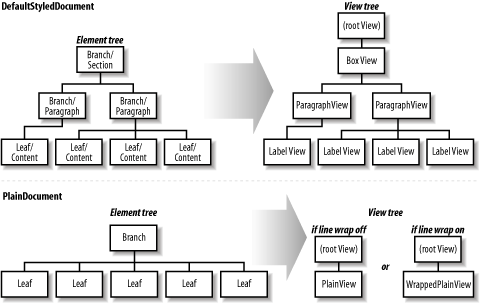Views
In our discussion of how Swing represents styled text, we
haven’t mentioned how it is actually drawn on the screen. That’s where
the View classes come in. They form
most of the V part of the MVC architecture for text components and are
responsible for rendering the text.
The way this works is a tree of View objects is created from the Document’s Element tree. (Examples of this are shown in
Figure 22-11.) For DefaultStyledDocuments in a JTextPane, the View tree is modeled closely on the structure
of the Element tree, with almost a
one-to-one mapping from Elements to
Views. A PlainDocument in a JTextArea is handled more simply, with a
single View object that paints the
entire Element tree.

Figure 22-11. View trees created from Element trees
Notice that the View trees have
a root View above what could be
considered the “natural” root. This was done to ease the implementation
of the other View classes, which can
now all assume that they have a non-null parent in the View tree. So that each child doesn’t have to
register as a DocumentListener, the
root View also takes care of
dispatching DocumentEvents to its
children. The actual type of the root View is a package-private inner class. (You
are free to create a View tree with
any root you like, so this does not always need to be the case. The
implementations of the TextUI.getRootView(
) method that Swing provides do return a package-private ...
Get Java Swing, 2nd Edition now with the O’Reilly learning platform.
O’Reilly members experience books, live events, courses curated by job role, and more from O’Reilly and nearly 200 top publishers.

